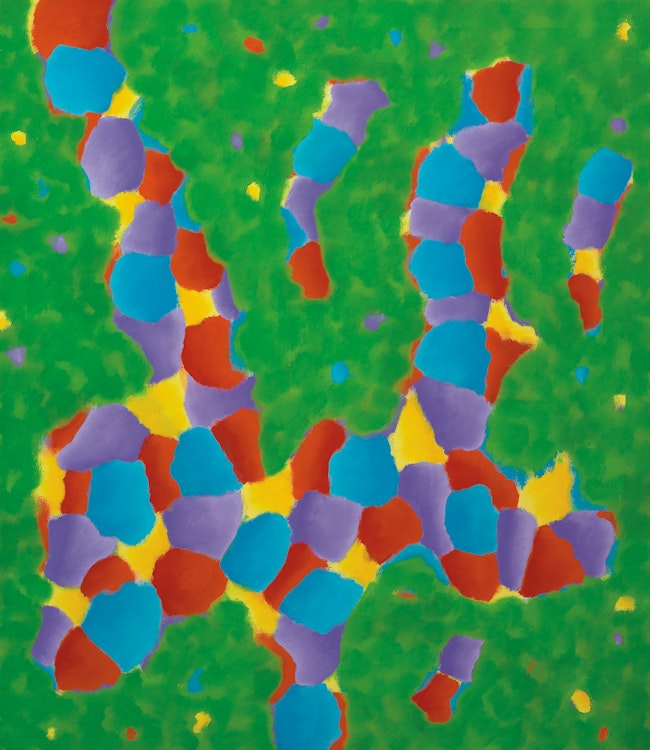Painting A by Gershon Iskowitz

Gershon Iskowitz
Painting A
oil on canvas
signed, titled and dated 1982 on the reverse
45 x 39 ins ( 114.3 x 99.1 cms )
Auction Estimate: $20,000.00 - $30,000.00
Price Realized $20,700.00
Sale date: November 22nd 2016
Private Collection, Calgary
Dennis Reid, “A Concise History of Canadian Painting”, third edition, Toronto, 2012, page 375
Peter Mellen, “Landmarks of Canadian Art”, Toronto, 1978, page 240
Roald Nasgaard, “Abstract Painting in Canada”, Toronto/Vancouver, 2007, page 244
David Burnett, “Iskowitz”, Art Gallery of Ontario, Toronto, 1982, page 72
Iskowitz drew on his personal recollections of experiences with landscape for his work, explaining that he would take “...the experience, out in the field, of looking up in the trees or in the sky, of looking down from the height of a helicopter. So what you try to do is make a composition of all those things, make some kind of reality... That’s painting.” The Canadian landscape provided him with striking patterns and vistas which emerged through tiers of scattered clouds below.
Nasgaard writes that, by the 1980s, Iskowitz had “upped the ante by electrifying his colours, intensifying their contrasts and hardening the contours of his forms.” “Painting A” exemplifies the artist’s unique manipulation of colour harmonies, textures and patterns, revealing the moment when “the landscape, the imagination, and the memory of experiences are united...”
Share this item with your friends
Gershon Iskowitz
(1919 - 1988) RCA
Born in Kielce, Poland, in 1919, Gershon Iskowitz immigrated to Canada in 1948 after surviving two Nazi concentration camps (Auschwitz labour camp in Poland and later Buchenwald, near Weimar, Germany). As a child, Iskowitz had an aptitude for art. He created advertisements for his local movie theatre in a section of his family’s living room that his father portioned off to create a small studio.
Following the Nazi occupation of Poland, Iskowitz was placed in the Kielce Ghetto. Once liquidated, Iskowitz was imprisoned in concentration camps in Poland and Germany. While he continued to make drawings during this period only two survive: Condemned (1944-46) and Buchenwald (1944-45). Upon liberation, he lived in the Feldafing Displaced Persons Camp and audited courses at the Academy of Fine Arts in Munich.
Upon receiving a temporary travel document from the Military Government for Germany, issued to stateless people, Iskowitz traveled to Canada via the United States in 1948 where his extended family greeted him at Union Station in Toronto. Until 1954, Iskowitz’s paintings focused on memories from his imprisonment. In the same year, he was included in the Canadian Society of Graphic Art exhibition at the Art Gallery of Ontario (AGO) alongside Painters Eleven artist Oscar Cahén.
By the 1960s Iskowitz’s style transformed from gestural to abstract. He became interested in exploring the Canadian landscape rather than his wartime memories during this period. After exhibiting at Gallery Moos in October 1964, for the first time, Iskowitz formed a close relationship with the owner, Walter Moos. Moos managed Iskowitz’s career and finances from this point forward. After receiving a Canada Council grant in 1967 he flew to Churchill, Manitoba. Entranced by aerial views he saw while in flight, Iskowitz began incorporating this perspective into his art.
Iskowitz was selected to represent Canada alongside Walter Redinger at the Venice Biennale in 1972 where he displayed four of these areal diptychs. In 1982, the AGO put on a retrospective exhibition of Iskowitz’s life work. After the retrospective exhibition had concluded, Iskowitz set up a foundation that would provide financial support to artists through an annual monetary prize, with assistance from Moos.
Literature Source: Ihor Holubizky, Gershon Iskowitz: Life and Work. Toronto: Art Canada Institute, 2018 (https://aci-iac.ca/art-books/gershon-iskowitz)
We extend our thanks to Danie Klein, York University graduate student in art history, for writing and contributing this artist biography.

